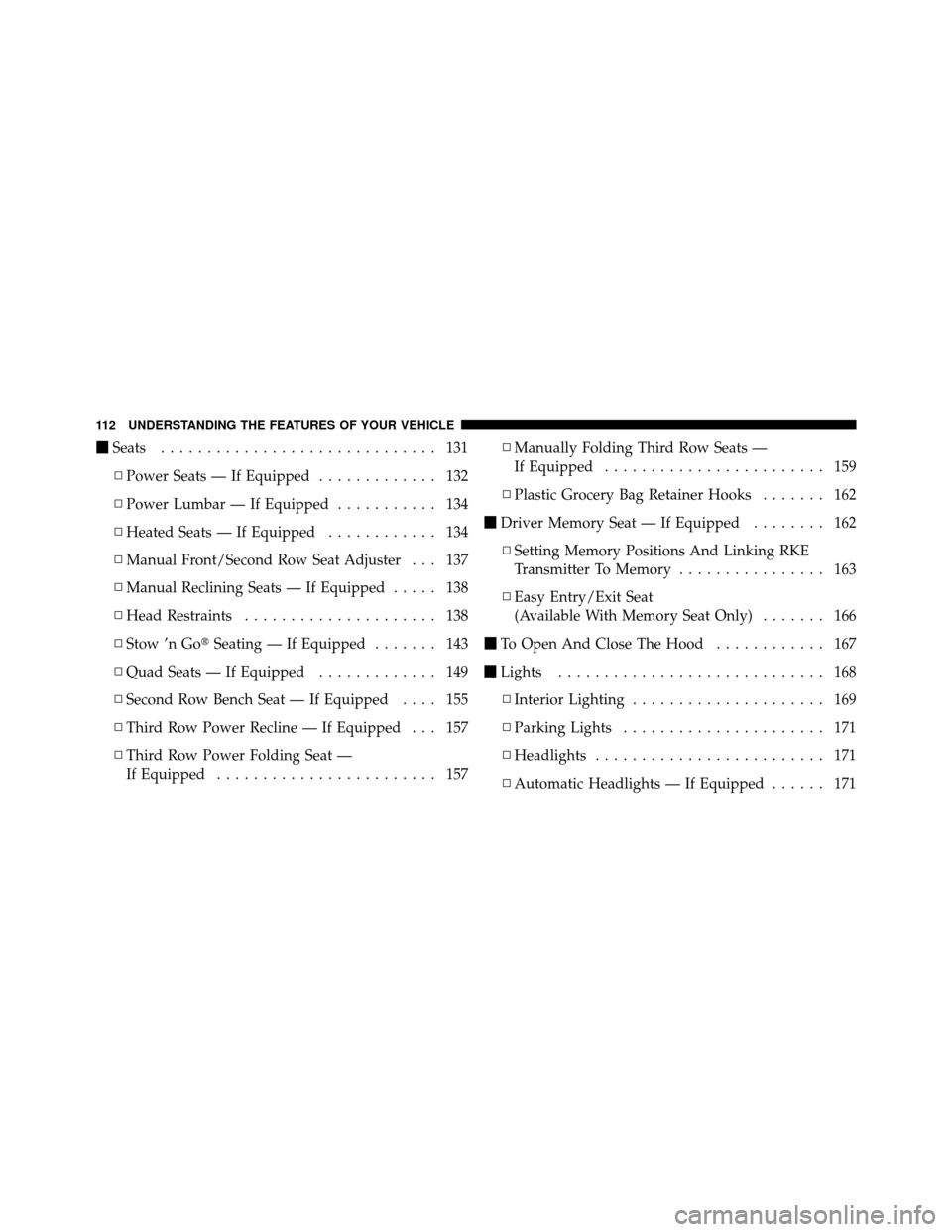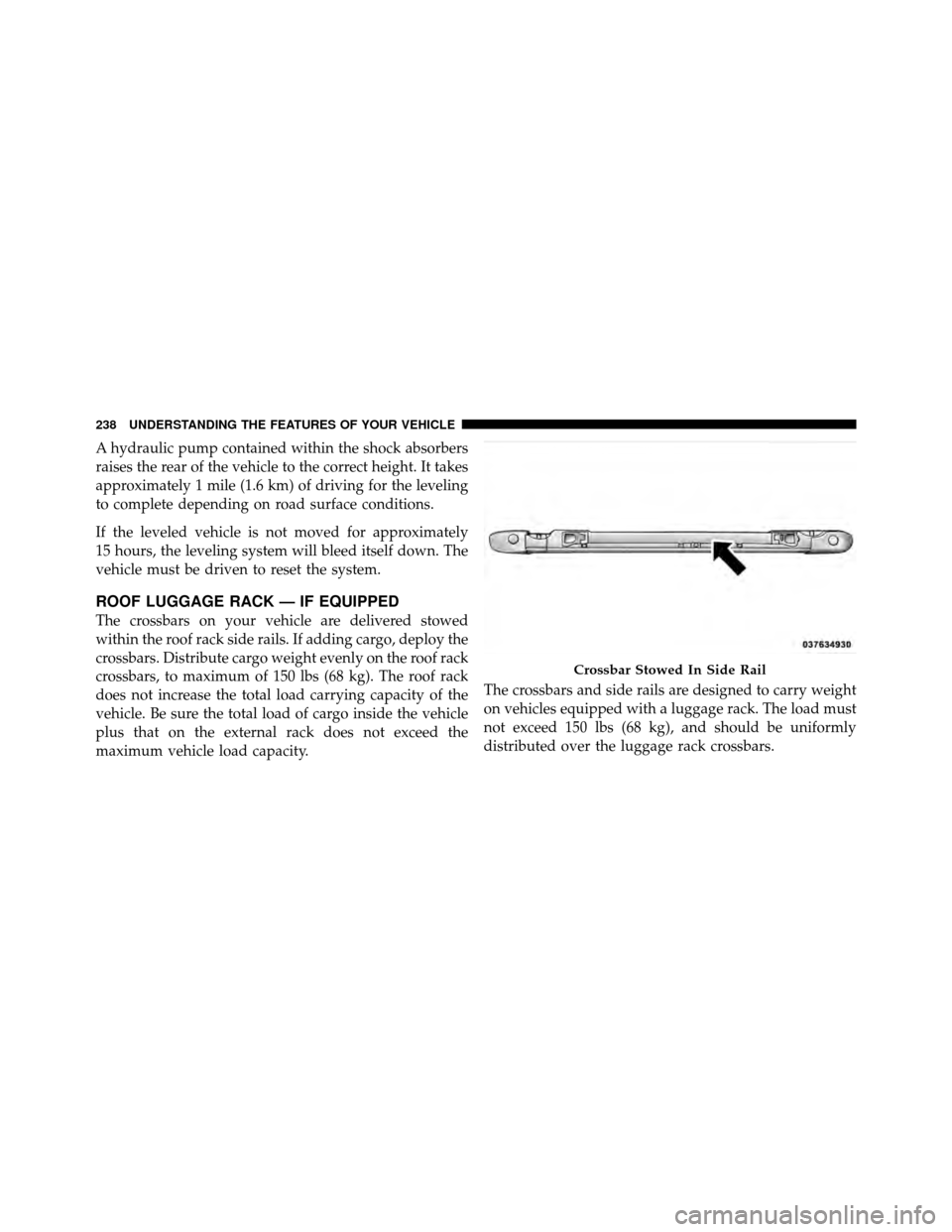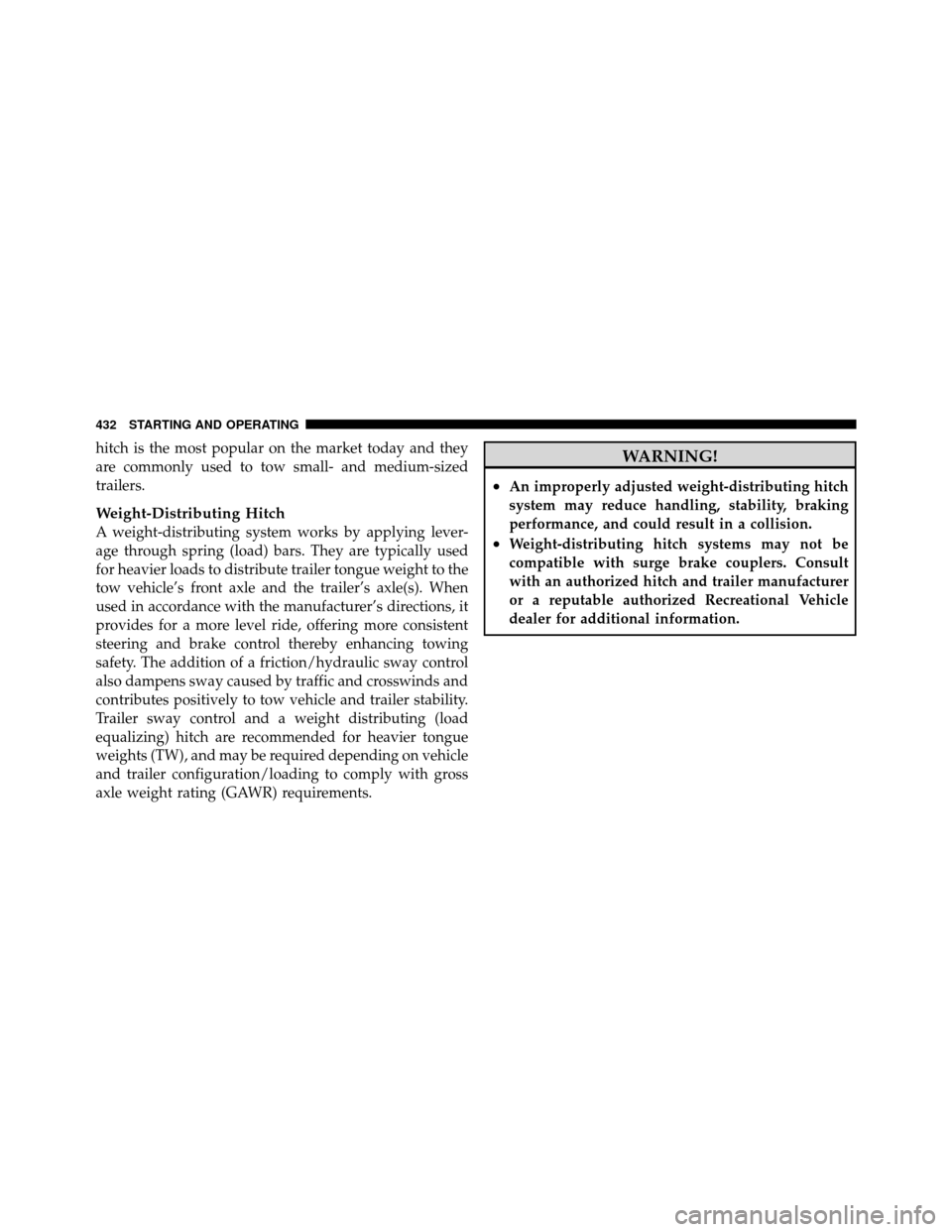Page 115 of 573

�Seats .............................. 131
▫ Power Seats — If Equipped ............. 132
▫ Power Lumbar — If Equipped ........... 134
▫ Heated Seats — If Equipped ............ 134
▫ Manual Front/Second Row Seat Adjuster . . . 137
▫ Manual Reclining Seats — If Equipped ..... 138
▫ Head Restraints ..................... 138
▫ Stow ’n Go� Seating — If Equipped ....... 143
▫ Quad Seats — If Equipped ............. 149
▫ Second Row Bench Seat — If Equipped .... 155
▫ Third Row Power Recline — If Equipped . . . 157
▫ Third Row Power Folding Seat —
If Equipped ........................ 157 ▫
Manually Folding Third Row Seats —
If Equipped ........................ 159
▫ Plastic Grocery Bag Retainer Hooks ....... 162
� Driver Memory Seat — If Equipped ........ 162
▫ Setting Memory Positions And Linking RKE
Transmitter To Memory ................ 163
▫ Easy Entry/Exit Seat
(Available With Memory Seat Only) ....... 166
� To Open And Close The Hood ............ 167
� Lights ............................. 168
▫ Interior Lighting ..................... 169
▫ Parking Lights ...................... 171
▫ Headlights ......................... 171
▫ Automatic Headlights — If Equipped ...... 171
112 UNDERSTANDING THE FEATURES OF YOUR VEHICLE
Page 241 of 573

A hydraulic pump contained within the shock absorbers
raises the rear of the vehicle to the correct height. It takes
approximately 1 mile (1.6 km) of driving for the leveling
to complete depending on road surface conditions.
If the leveled vehicle is not moved for approximately
15 hours, the leveling system will bleed itself down. The
vehicle must be driven to reset the system.
ROOF LUGGAGE RACK — IF EQUIPPED
The crossbars on your vehicle are delivered stowed
within the roof rack side rails. If adding cargo, deploy the
crossbars. Distribute cargo weight evenly on the roof rack
crossbars, to maximum of 150 lbs (68 kg). The roof rack
does not increase the total load carrying capacity of the
vehicle. Be sure the total load of cargo inside the vehicle
plus that on the external rack does not exceed the
maximum vehicle load capacity.The crossbars and side rails are designed to carry weight
on vehicles equipped with a luggage rack. The load must
not exceed 150 lbs (68 kg), and should be uniformly
distributed over the luggage rack crossbars.
Crossbar Stowed In Side Rail
238 UNDERSTANDING THE FEATURES OF YOUR VEHICLE
Page 242 of 573
NOTE:
•Crossbars are error-proofed and cannot be deployed or
stowed in the incorrect positions.
•To help control wind noise, stow the crossbars in the
side rails when they are not in use.
Deploying the Crossbars
To deploy the crossbars, completely loosen the thumb
screws at both ends of the crossbar and lift the crossbar
from its stowed position in the side rail. Repeat with
crossbar on the opposite side.
CAUTION!
Use care when removing and handling the crossbars
to prevent damage to the vehicle.
Loosening Crossbars
3
UNDERSTANDING THE FEATURES OF YOUR VEHICLE 239
Page 243 of 573
Bend the crossbar supports at each end, taking care to
keep hand clear of pivoting joint. Slide the thumb screw
down.Then, position the crossbars across the roof.
Stowed Position
Deployed Position
240 UNDERSTANDING THE FEATURES OF YOUR VEHICLE
Page 245 of 573
Once the crossbars are set into position, tighten the
thumb screws completely.Stowing the Crossbars
Reverse the procedure to stow the crossbars, again,
taking care to keep hand clear of pivoting joint. Crossbars
are identical and can be stowed in either rail nest. Once
the crossbars are stowed, tighten the thumb screws
completely.
NOTE:Load should always be secured to crossbars
first, with rail tie down loops used as additional securing
points if needed. Tie loops are intended as supplemen-
tary tie down points only. Do not use ratcheting mecha-
nisms with the tie loops.
Tightening Crossbar
242 UNDERSTANDING THE FEATURES OF YOUR VEHICLE
Page 435 of 573

hitch is the most popular on the market today and they
are commonly used to tow small- and medium-sized
trailers.
Weight-Distributing Hitch
A weight-distributing system works by applying lever-
age through spring (load) bars. They are typically used
for heavier loads to distribute trailer tongue weight to the
tow vehicle’s front axle and the trailer’s axle(s). When
used in accordance with the manufacturer’s directions, it
provides for a more level ride, offering more consistent
steering and brake control thereby enhancing towing
safety. The addition of a friction/hydraulic sway control
also dampens sway caused by traffic and crosswinds and
contributes positively to tow vehicle and trailer stability.
Trailer sway control and a weight distributing (load
equalizing) hitch are recommended for heavier tongue
weights (TW), and may be required depending on vehicle
and trailer configuration/loading to comply with gross
axle weight rating (GAWR) requirements.
WARNING!
•An improperly adjusted weight-distributing hitch
system may reduce handling, stability, braking
performance, and could result in a collision.
•Weight-distributing hitch systems may not be
compatible with surge brake couplers. Consult
with an authorized hitch and trailer manufacturer
or a reputable authorized Recreational Vehicle
dealer for additional information.
432 STARTING AND OPERATING
Page 472 of 573
5. Using a small screwdriver or similar small, push and
hold the override release lever forward.
6. Move the shift lever into the NEUTRAL position.7. The vehicle may then be started in the NEUTRAL
position.
8. Reinstall the shift lever override access cover.
TOWING A DISABLED VEHICLE
Towing Condition
Wheels OFF the Ground ALL MODELS
Flat Tow NONEIf transmission is operable:
•Transmission inNEUTRAL
•25 mph (40 km/h)max speed
•15 miles (24 km)maxdistance
Wheel lift Rear
Front OK
Flatbed ALLBEST METHOD
Proper towing or lifting equipment is required to prevent
damage to your vehicle. Use only tow bars and other
equipment designed for the purpose, following equip-
ment manufacturer ’s instructions. Use of safety chains is
mandatory. Attach a tow bar or other towing device to main structural members of the vehicle, not to bumpers
or associated brackets. State and local laws applying to
vehicles under tow must be observed.6
WHAT TO DO IN EMERGENCIES 469